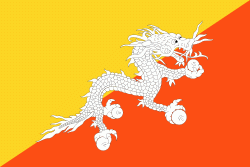Dzongkha language
Dzongkha is a Sino-Tibetan language that is the official and national language of Bhutan. It is written using the Tibetan script.
The word dzongkha means "the language of the fortress", from dzong "fortress" and kha "language". , Dzongkha had 171,080 native speakers and about 640,000 total speakers.
Dzongkha is considered a South Tibetic language. It is closely related to and partially intelligible with Sikkimese, and to some other Bhutanese languages such as Chocha Ngacha, Brokpa, Brokkat and Lakha. It has a more distant relationship to Standard Tibetan. Spoken Dzongkha and Tibetan are around 50 to 80 percent mutually intelligible.
Dzongkha and its dialects are the native tongue of eight western districts of Bhutan (viz. Wangdue Phodrang, Punakha, Thimphu, Gasa, Paro, Ha, Dagana and Chukha). There are also some native speakers near the Indian town of Kalimpong, once part of Bhutan but now in North Bengal and in Sikkim.
Dzongkha was declared the national language of Bhutan in 1971. Dzongkha study is mandatory in all schools, and the language is the lingua franca in the districts to the south and east where it is not the mother tongue. The Bhutanese films Travellers and Magicians (2003) and Lunana: A Yak in the Classroom (2019) are in Dzongkha.
The word dzongkha means "the language of the fortress", from dzong "fortress" and kha "language". , Dzongkha had 171,080 native speakers and about 640,000 total speakers.
Dzongkha is considered a South Tibetic language. It is closely related to and partially intelligible with Sikkimese, and to some other Bhutanese languages such as Chocha Ngacha, Brokpa, Brokkat and Lakha. It has a more distant relationship to Standard Tibetan. Spoken Dzongkha and Tibetan are around 50 to 80 percent mutually intelligible.
Dzongkha and its dialects are the native tongue of eight western districts of Bhutan (viz. Wangdue Phodrang, Punakha, Thimphu, Gasa, Paro, Ha, Dagana and Chukha). There are also some native speakers near the Indian town of Kalimpong, once part of Bhutan but now in North Bengal and in Sikkim.
Dzongkha was declared the national language of Bhutan in 1971. Dzongkha study is mandatory in all schools, and the language is the lingua franca in the districts to the south and east where it is not the mother tongue. The Bhutanese films Travellers and Magicians (2003) and Lunana: A Yak in the Classroom (2019) are in Dzongkha.
Country
-
Bhutan
Bhutan (འབྲུག་ཡུལ་ ), officially the Kingdom of Bhutan (འབྲུག་རྒྱལ་ཁབ་), is a landlocked country in South Asia. It is situated in the Eastern Himalayas, between China in the north and India in the south. A mountainous country, Bhutan is known locally as "Druk Yul" or "Land of the Thunder Dragon", a name reflecting the cultural heritage of the country. The exonym Bhutan likely derives from the Prakrit hybrid word Bhŏṭṭaṃta, a name referring to its geographical proximity to Tibet. Nepal and Bangladesh are located near Bhutan but do not share a border with it. The country has a population of over 727,145 and territory of 38394 km2 and ranks 133rd in terms of land area and 160th in population. Bhutan is a constitutional monarchy with a king (Druk Gyalpo) as the head of state and a prime minister as the head of government. Vajrayana Buddhism is the state religion and the Je Khenpo is the head of state religion.
The subalpine Himalayan mountains in the north rise from the country's lush subtropical plains in the south. In the Bhutanese Himalayas, there are peaks higher than 7000 m above sea level. Gangkhar Puensum is Bhutan's highest peak and is the highest unclimbed mountain in the world. The wildlife of Bhutan is notable for its diversity, including the Himalayan takin and golden langur. The capital and largest city is Thimphu, holding close to 1/7th of the population.
